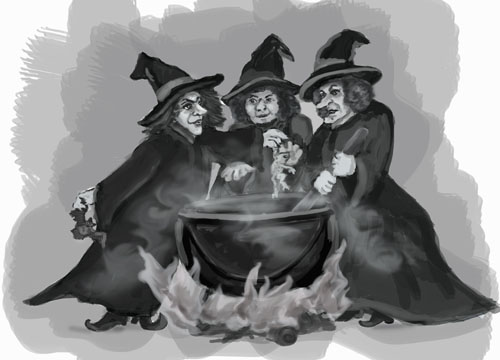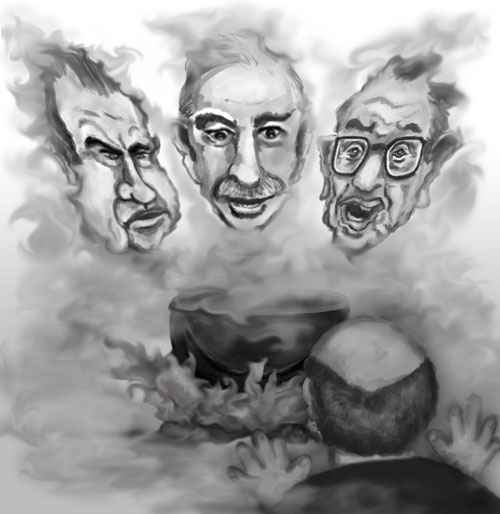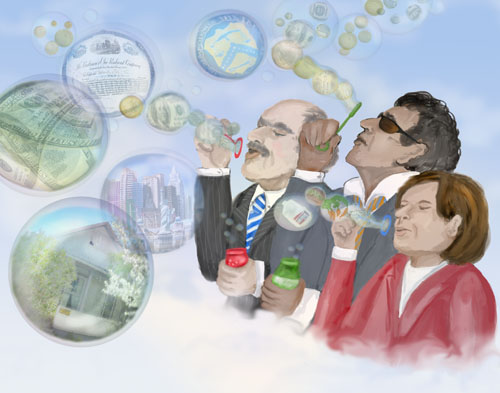The Tragedie of Macben and the Bubble Economie
Act 4
In an abandoned Metro tunnel deep below the nation’s capital, three witches are conjuring up trouble for Macben. As they parade around a steaming cauldron, the faint rumbling of an Orange Line train can be heard in the distance.
First Witch
Thrice the brittle hedge funds stumbled
Second Witch
Thrice and once the walled street tumbled
Third Witch
Speculators cry “‘Tis time, ’tis time.”
First Witch
Round about the cauldron go;
In the poison’d debt throw:
Freddie Mac and Fannie Mae
A-I-G and B-of-A
Goldman Sachs and rich folks tax
Dash of TARP and spoiled carp
Medicare and Medicaid
Student loans and underwater homes
Securitize and monetize
All
Double, double, toil and trouble;
Economy burn and cauldron bubble.
Second Witch
Pundits mumble, never humble
Irrational exuberance and unwise bets
Greek debt and subprime mortgages
Offshored jobs and moribund industries
Bloated bonuses and insider trading
Bernie Madoff and R. Allen Stanford
Into the cauldron hot and deep
All
Double, double, toil and trouble;
Economy burn and cauldron bubble.

The triple witching hour has arrived and the Weird Sisters are preparing a potion to cast powerful spells upon the economie
Third Witch
Real estate crumble, derivatives fumble
Bankers grumble and Congress bumble
Unemployment riseth and inflation loometh
Administration waverth and GSA partieth
Treasury selleth and China buyeth
Liquidity traps and shadow stats,
Mark-to-market, bondholder haircut
Moody’s, Fitch and S&P
Sovereign downgrades and party of tea
QE1, QE2 and QE3 soon to be
Manipulate and stimulate
All
Double, double, toil and trouble;
Economy burn and cauldron bubble.
Second Witch
Cool it with a failed IPO,
Then the charm is firm and good.
Enter Geitnercate with three witches
Geitnercate
Oh well done! I commend your pains,
And every one shall share i’ th’ capital gains.
And now about the cauldron sing,
Like bulls and bears in a ring,
Enchanting all that you invest in.
Second Witch
By the picking of my stocks
Something wicked this way comes.
Open, locks,
Whoever knocks.
Macben
How now, you secret, black, and midnight hags?
Has the dreaded hour of triple witching at last arrived?
What is ’t you do?
All
A deed that goes by many names.
Macben
I conjure you by that which you profess—
Howe’er you come to know it,
Insider information or salmon coloured journal
Answer me.
Though you untie the currencies and let them fight
Against the banks, though the yeasty valuations
Confound hedge fund managers and day traders alike
Though swaps be lodged and derivatives blown down,
Though investment houses topple on their warders’ heads,
Though online brokerage firms do slope
Their revenues to their foundations, though the treasure
Of the world economy tumble all together,
Even till destruction sicken, answer me
To what I ask you.
First Witch
Speak
Second Witch
Demand
Third Witch
We’ll answer
First Witch
Say, if th’ hadst rather hear it from our mouths,
Or from our masters’.
Macben
Call ’em. Let me see ’em.
First Witch
Pour in the tears of analysts that hath eaten red ink
Add lobbyist’s grease that graced the Congressional palms
Into the flame
All
Come, high or low;
Thyself and office deftly show!
A burst of light flashes down the darkened tunnel.
An apparition slowly rises from the steaming cauldron.
It is the ghost of renowned stimulator John Maynard Keynes
.
Macben
Tell me, thou long lamented sage
First Witch
He knows thy thoughts
Hear his speech, but say thou nought.
First Apparition
Macben! Macben! Macben!
Beware McRon, the thane of Paul.
Be seduced not by his gilded standard
Instead manipulate and stimulate
Dismiss me. Enough!
The specter descends back into the cauldron.
Macben
Wherever thou art, for thy good caution, thanks
Thou hast harp’d my fear aright. But one word more—
Will fair Fedres be occupied, audited or perchance abolished?
First Witch
He will not be commanded. Here’s another
More potent than the first
.
A thunderclap is heard. A second apparition slowly resolves from the cauldron’s steamy mist. It is the ghost of Richard Nixon, slayer of the gold standard and champion of fiat money.
.
.
Second Apparition
Macben! Macben! Macben!
Macben
Had I three ears and Siri too, I’d hear thee, o tormented spirit.
Second Apparition
Be greedy, bold, and resolute. Laugh to scorn
The allure of gold and its falsehearted charm
For as long as the presses roll
No harm shall visit Macben
Macben
Then preach on. What need I fear of McRon?
But yet I can’t be double sure, so I take my chance
That the fates will prescribe no nomination
And that I may continue to voice pale-hearted lies
And slumber roundly innocent of inflationary dread.
Nixon’s ghost dissolves back into the eerie fog
.
.
A lightning bolt flashes. A third apparition rises from the steaming cauldron. It is the doppelgänger of Alan Greenspan, the architect of the great housing bubble
.
Macben
What is this spirit
That rises like the issue of an elder,
Wearing upon his bald-brow creases of wisdom
While pronouncing equivocal fedspeak
Third Apparition
Be lion-mettled, proud, and take no care
Who chafes, who frets, or where investigators skulk.
Fedres shall never ruined be until
Great Bretton Woods to Foggy Bottom
Shall come against Macben.
Macben
That will never be.
Who can impress the forest, bid the tree
Unfix his earthbound root? Sweet bodements! Good!
Inflation dead, to emerge never till the woods
Of Bretton rise, and our high-placed Macben
Shall live the life of leisure, pay his breath
To time and mortal custom. Yet my heart
Throbs to know one thing. Tell me, if your art
Can tell so much: shall Bankwoe’s issue ever
Govern in this land?
The apparition condenses down into the cauldron

Macben recoils in horror when he is confronted by the ghosts of Keynes, Nixon and Greenspan and hears their dire predictions.
All
Seek to know no more.
Macben
I will be satisfied: deny me this,
And an eternal recession shall fall upon you! Let me know.
Why sinks that cauldron? and what noise is this?
To be continued…
Illustration by Kim Harris
Story by Don Rudisuhle





